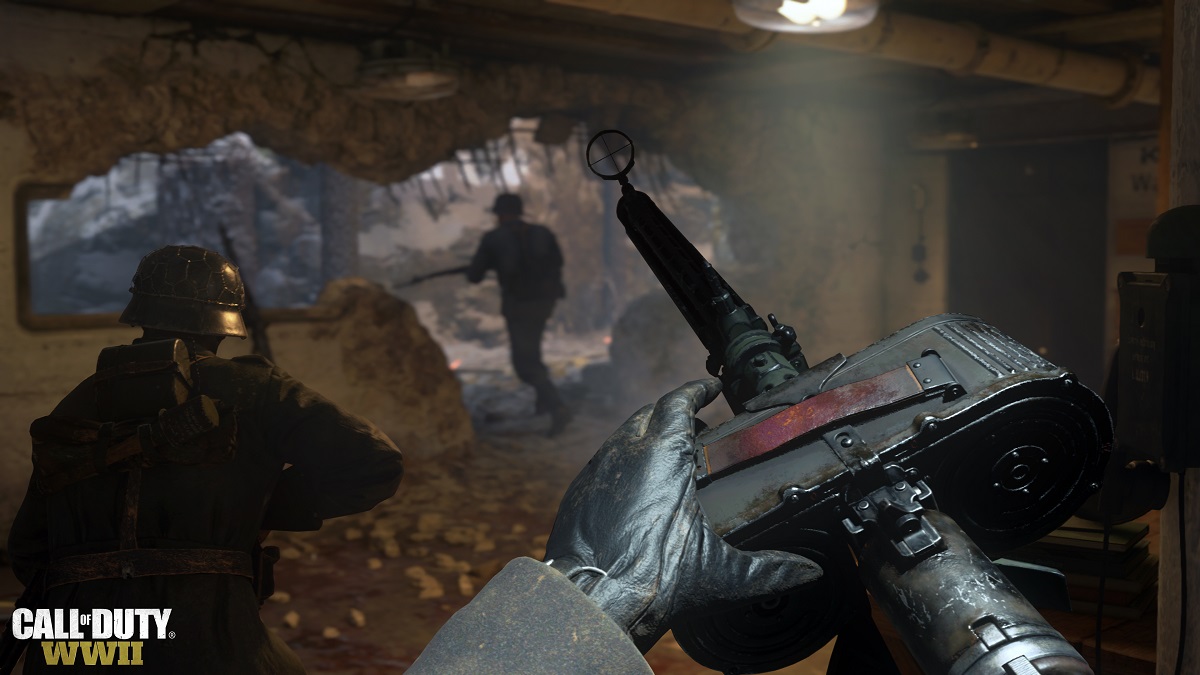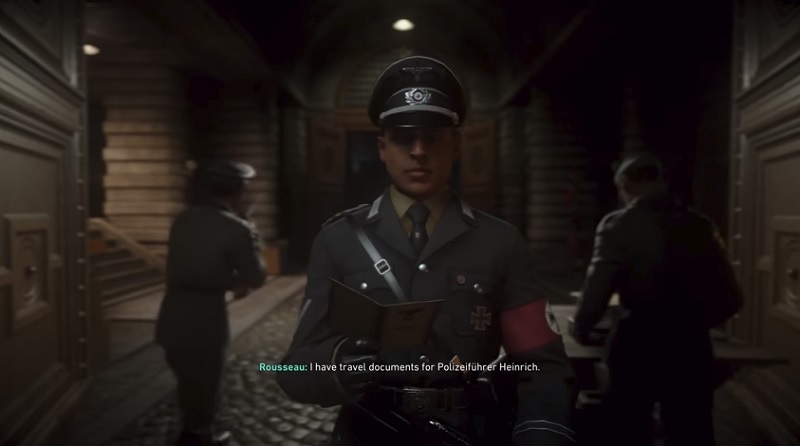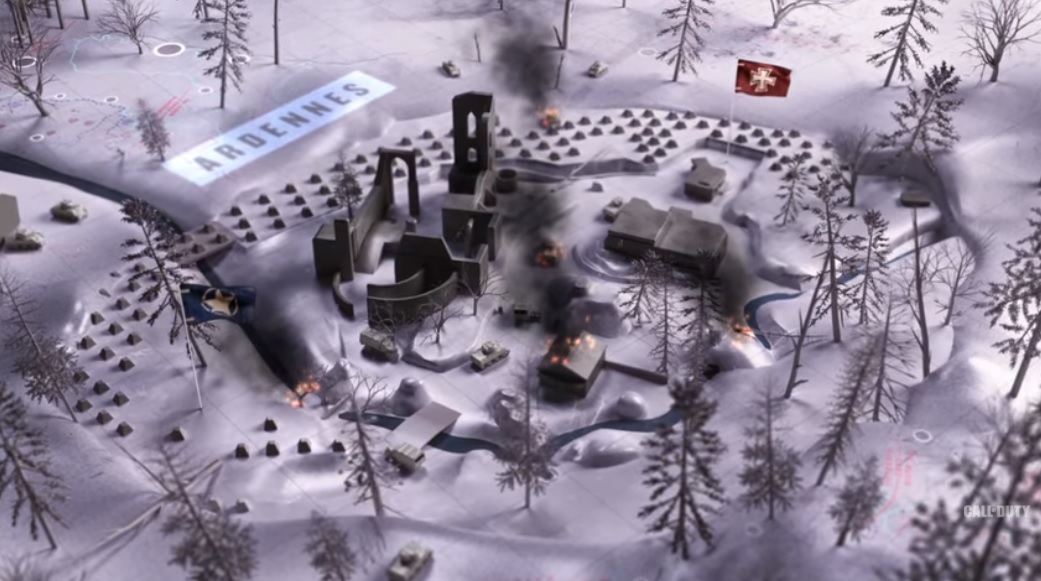Call of Duty: WWII takes us back the beginning. It reminds us why we liked the series and why it became a $15 billion juggernaut. The military shooter puts you in the shoes of individual infantry soldiers, the ordinary people who learn what it means to become a hero, without celebrating war or forgetting about all of its horrors. It helps us remember the sacrifices of those who came before us, and why Call of Duty has sold more than 250 million units sold since 2003.
Sledgehammer Games undertook the mission of returning Call of Duty to the Second World War three years ago, a timely move considering last year’s disappointing performance for the science fiction shooter Call of Duty Infinite Warfare. Sledgehammer’s team of 300 people studied the war that claimed 65 million lives. The team traveled to Europe and felt what it was like to freeze during the winter nights in France, Belgium, and Germany. They consulted with historians to get the history of the U.S. Army’s 1st Infantry Division, and they pooled their storytelling DNA to tell the story of a single squad within the Fighting First.

Above: Multiplayer combat in Call of Duty: WWII.
The result is a game that stays true to the mission. It honors the memory of ordinary people who became heroes under extraordinarily difficult conditions, as those veterans are no longer around to talk about it. It tells the story of men and women — from female French Resistance leaders to African American officers and Jewish soldiers — whose stories were left out of many histories. It shows the horror of combat, from brutal knife fights to death by flamethrowers. It entertains video game players with boots-on-the-ground combat. And while it encourages you to be a hero, you are not a lone wolf. The story shows that a hero is somebody who does something for others, like a friend, a squad, or the larger cause of the war.
This story has some story spoilers. Check out our Reviews Vault for past game reviews. And here’s our other Call of Duty coverage.
June 5th: The AI Audit in NYC
Join us next week in NYC to engage with top executive leaders, delving into strategies for auditing AI models to ensure fairness, optimal performance, and ethical compliance across diverse organizations. Secure your attendance for this exclusive invite-only event.
I attended an Activision review event and played through the 12-mission single-player campaign, which follows the squad of the Big Red One from D-Day to the Rhine. I also played the multiplayer, from the objective-oriented War mode to the hilarious Gridiron fantasy. And I got a taste of the Nazi Zombies co-op mode. Activision has packed several games into one package, delivering a value that fans have come to expect each year. I’m on my second run through single-player, now on the hardened difficulty setting, or one notch above regular. And I am thoroughly enjoying myself, as I find that each battle has been well-conceived with a good beginning and ending.
What you’ll like
A story that focuses on a single squad

Above: Private Robert Zussman in Call of Duty: WWII.
Call of Duty: WWII tells the personal story of soldiers forming a tight bond while also delivering a panoramic view of a war where the cause was good but the fighting was brutal.
When you land on the beach, you don’t even have a gun. Captain Turner tells you to remember your training and that your job is to pick up an explosive tube, dubbed a Bangalore torpedo, rush to the barbed wire, and blow a breach in it for others to move up the beach. This landing reinforces the idea that your first duty is to your fellow soldiers and your own squad. You aren’t shooting at all. Your job is to make sure that the other soldiers get through the wire to assault the bunkers, and eventually you have to save the life of a comrade who first saves you.
The squad fights through a dozen horrific battles in the single-player campaign. Each one is like its own nightmare. You crawl up Omaha Beach through withering fire. You drive a jeep through enemy lines. You face an artillery ambush that shatters the trees above you. You learn to stick with your comrades and make the ultimate sacrifices for them. During the battles, you are called upon to do heroic actions, like dragging a fallen soldier to safety, capturing enemies instead of shooting them, or escorting a little girl away from the fighting. Such acts of humanity take place against the backdrop of a war that was brutal in almost every way, from the collateral damage on civilians to the mistrust it bred among the conquered populations.
One of the stars, Ronald “Red” Daniels (played by Josh Duhamel) forms a bond with Jewish private Robert Zussman. They promise to protect each other’s backs, and in multiple missions they are called to live up that promise. Daniels saves Zussman after he has been stabbed, guards him with a sniper rifle as Zussman plants explosives, and searches for Zussman after he has been taken captive. Among the many stories, this one focuses on what blood brothers will do for each other.
Daniels is haunted by his past relationship with his own brother, and he knows it only takes a moment to determine if you’ll be remembered as a hero or a coward. From the very first battle, he learns that keeping your buddies alive is the highest duty, and that you don’t leave anyone behind. I constantly worried that one of these guys wouldn’t make it, and that meant Sledgehammer had created an emotional bond.
The story doesn’t flinch from real issues

Above: You are part of a squad in the 1st Infantry Division in Call of Duty: WWII.
Sledgehammer was careful to respect the sacrifices of those who fought the war without glorifying war itself. It showed both the good and the bad of the American war effort. You liberate Paris and save the French, but you also see things that were otherwise buried in the official histories.
There is unexplained tension among the Jewish American soldier, Zussman, and his superiors. A black officer doesn’t get respect from one of his squad mates. A woman infiltrates a Nazi compound in Paris, kills the commander responsible for her family’s death, and then sets bombs to let the Americans into the compound. It is a reminder of the role that women played in the war.
There’s more diversity in this story than many of the old history books. When one of these characters comes to life in front of you, it makes you question your assumptions. Sledgehammer might be viewed as pandering to diversity interests, imposing a modern moral sensibility on history. But if you scratch below the surface, you’ll find that this diverse lot of people actually fought in the war, and the issues that they raise are real.
Immersive realism

Above: Winter fighting in Call of Duty: WWII.
In the Hürtgen Forest, you really feel like you’re in the beautiful woods. Then German artillery rains down on you. The shells are pre-set to explode in the trees above you, so that the exploding wood sends splinters in all directions. The sound of splitting wood and the whoosh of artillery makes you feel like you’re really there, trapped in an ambush and racing through the forest to try to escape the barrage.
When soldiers breathe in the Ardennes, you see the frost coming from their mouths. It’s a small but nice touch that shows the attention to detail. There were a few times where I thought the facial animation wasn’t perfect. But most of the time, the transitions between the pre-rendered cinematics and the in-game animations were superb.
Inside a Normandy bunker, I got ambushed by a Nazi hiding behind the door. I fought him off and smashed his face with his helmet. I tossed it on the floor, and the helmet clanked and sent an echo through the bunker. I felt immersed in the moment. Such realism helps convey the brutality of war.
Multiplayer isn’t impossible anymore

Above: Call of Duty: WWII
Multiplayer is a survival of the fittest. I was pretty disappointed with my performance in last year’s Call of Duty: Infinite Warfare. My kill-death ratio sank to an all-time low of around 0.40 — that means I was dying more than two times for every one kill I earned. But in WWII, my kill-death ratio is creeping back up.
The return to World War II has slowed the pace of multiplayer. You have time to think about your survival, to take your shots, and to hide behind cover when necessary. This is good for players with rusty reflexes.
There are also more ways to practice to get better. In the Headquarter social hub, you can play one-on-one challenges and practice how to use Scorestreaks or weapons. All of that means that you’ll have a better experience as you go from noob to a veteran.
War Mode stands out in particular because you aren’t just out for the kills anymore. Like Electronic Arts’ Battlefield shooters, War has multiple objectives that you have to take in order to win. Each match has two halves, and you switch sides at halftime. To succeed in this match type, each player must fulfill a crucial role. The emphasis isn’t on the kill-death ratio at all. It’s the best part of multiplayer because it forces players to find and fulfill a role in order to win.
Nazi Zombies is a nice bonus

Above: Time to use the shovel on a Nazi zombie.
Zombies has come into its own as a staple of just about every Call of Duty release, and it’s a nice fit for people who want some crazy co-op action combined with a story that takes itself seriously. In the latest entry of the Zombies saga, Nazi occult scientists try to bring back the undead as a last-ditch effort to win the war. A group of Monuments Men (and women) stumble upon the Nazi plot while searching for lost artifacts. Simultaneously, engineering wiz Marie Fischer also crosses paths with the walking corpses while she is looking for her missing brother Klaus.
When all hell breaks loose, you and your team control this group of survivors through wave after wave of zombie attacks. As usual, you get a chance to upgrade your weapons, heal yourself, and replenish your ammo between each round. If you get taken down, your friends can heal you. More than ever, Zombies feels like it is going to graduate to its own game.
What you won’t like
History could have played a bigger role

Above: The D-Day landing in Call of Duty: WWII.
There are small moments when Sledgehammer Games could have passed on a history lesson to a younger generation, and it didn’t. When you land on Omaha Beach on June 6, 1944, the caption reads, “Normandy Beaches.” Why doesn’t it just say Omaha Beach, which carries a more impactful historical significance to the people who know their history?
I love history, and I wish everybody shared that passion. This game seems like it might be the only history lesson that many people will get. I appreciate how much time and effort they put into the research. But Sledgehammer could have gone deeper, embedding more of that history in more places in the game.
By contrast, Assassin’s Creed Origins is chock full of educational lessons about Ancient Egypt. Sledgehammer Games developers say they had to balance educational history with fun. They wanted to entertain us with a video game. But I think the pendulum swung too far to fun. I feel there could have been more impact and weight from the full force of history. At the end of the D-Day mission, Sledgehammer moves on without giving context about how many soldiers sacrificed their lives in the battle that you just survived.
There isn’t much of a villain

Above: The French Resistance mission requires stealth.
Previous Call of Duty games had memorable villains like Raul Menendez in Call of Duty: Black Ops II or Kevin Spacey’s Jonathan Irons in Call of Duty: Advanced Warfare.
But this game never really takes you inside the minds of the Nazi villains. You encounter evil Nazi commanders like one who is trying to sort through the prisoners of war to find Jews, or another who oppresses the conquered French population in Paris. But they have small roles in the game and don’t make a lasting impression. They aren’t at all like the memorable evil characters in Inglorious Basterds or Wolfenstein II: The New Colossus.
The result is that you have a grand cause to fight the Nazi oppression, but you don’t have a personal cause to take revenge against anyone. In some ways, this is a good thing. The game teaches you the horrors of war, but it doesn’t teach you to hate the German people. The soldiers even have a conversation about this lesson during a quiet moment, drawing a line between ordinary people and Nazi ideology. You learn what the Nazis did, particularly how they treated the Jews and the prisoners of war. Still, I worry this game won’t be as memorable because it doesn’t have a super villain.
The mismatched tones of the campaign and multiplayer modes

Above: The Ardennes map in Call of Duty: WWII.
The serious tone of the single-player campaign isn’t carried on into the multiplayer combat. That destroys some of the immersion.
The single-player campaign makes you feel like you are on one of the greatest endeavors of mankind. With multiplayer, you show up at the Headquarters location on Omaha Beach, and the officer who greets you talks about — your multiplayer career. You can request supply drops of loot that coming falling from the sky. It breaks the idea that you are part of history, and you are just trying to survive or help bring your buddies back home.
Instead, it suggests the awkward notion that you could be the next esports hero or compete better against other players. To me, that’s a mismatch which could have been addressed in some way. The transition to Nazi Zombies isn’t as awkward, as the story leads you on a serious exploration of Nazi science and its obsession with the occult. The tone mismatch raises the question. Is this an esports vehicle, or a story that carries the gravity of history?
Conclusion

Above: Flamethrower in Call of Duty: WWII
Eric Hirshberg, CEO of Activision Publishing, told me in an interview in June that Activision may have stayed with science fiction for a year too long with last year’s Call of Duty: Infinite Warfare, and that everybody agreed that going back to World War II was a good idea.
I think so too. Call of Duty games are as big as they come. Activision has the luxury of having three studios making them, giving them three years to complete each title — not to mention the team dedicated to multiplayer. That’s as big an investment as anyone makes in a single video game franchise. And in the case of Call of Duty: WWII, it really pays off. My hat’s off to the developers at Sledgehammer who are helping a new generation understand the sacrifices of those who died in the Second World War.
I’ve brought up a few things I didn’t like. But they are relatively small blemishes when you think about the whole game. Multiplayer is better because of War mode and the slowing of the superhuman speeds. Nazi Zombies has roots in the Nazi interest in the occult. And the single-player campaign follows a squad with characters that you care about through a sweeping journey through some of the most epic battles of the war. Each battle is intense, and the attention to details of the imagery — like the quality of the water in a stream running through a forest — is amazing. It’s an authentic Call of Duty.
Some people think it’s trite and repetitive to hear all this talk about history and sacrifice. But I look around at the world today — which still has people who espouse the Nazi ideology — and I feel like we still need to learn. The ending of WWII takes us into the Nazi prison camps, and the scenes of atrocity are a grim reminder of where that ideology leads. It is a fitting ending, which resonates with many of the eariler scenes in the game, and it’s a personal one at that.
Score: 94/100
Call of Duty: WWII is available now for PC, Xbox One, and Playstation 4. The publisher provided GamesBeat with a copy of PS4 edition of the game for this review, and I attended a review event.


